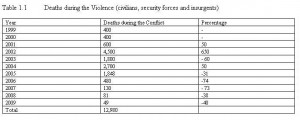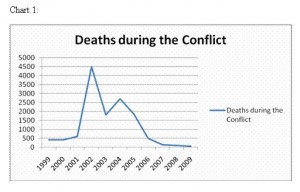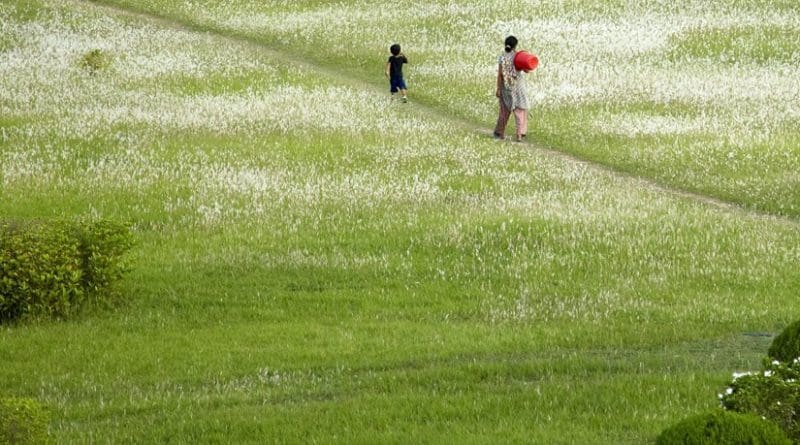Conflict and Peace in Nepal – Analysis
By SAAG
By Dr. Hari Bansh Jha
With population of nearly 30 million (July 2010), Nepal is one of the poorest countries in the world. Over 80 per cent of the population in the country is directly or indirectly involved in agricultural activities. As per the preliminary study of Central Bureau of Statistics, the per capita gross national income (GNI) in Nepal recorded as low as $568 in 2009-10; while the annual rate of economic growth was 3.5 per cent.[1] Nearly 55 per cent of the people in the country fall below the international poverty measures of $ 1.25 per day. The country is facing drought, acute shortage of food and the highest level of hunger in 40 years.
According to the recent report published by the Asian Development Bank, Nepal recorded biggest increase in inequality together with China and Cambodia. About 46 per cent of the people in Nepal are underemployed and unemployed.[2] Each day over 600 Nepalese people flee the country for employment in countries other than in India.
Many of the problems in Nepal are the outcome of the armed conflict of 10 years beginning from 1996. Over 16,000 people were killed due to the conflict, which directly affected the life of 450,000 of their family members. During the conflict, 5,800 people were disabled, 71,200 people were internally displaced, 25,000 children were orphaned, and 9,000 women were widowed. Besides, 1,350 persons were disappeared. Property of 11,000 people was damaged.[3] Several government offices, schools, bridges and police posts were damaged.
Human Cost of Conflict

The following table indicates that 12,980 persons including the civilians, security forces and insurgents were killed between 1999 and 2009. In 1999, 400 persons were killed. The figure peaked up to 4,500 in 2002. Though the number of causalities somewhat declined in the subsequent years, the death figures were still very high until 2005. As many as 1,800 people were killed in 2003, 2,700 people in 2004 and 1,848 people in 2005. The number of people killed declined perceptibly to 480 in 2006, 130 in 2007, 81 in 2008 and 49 in 2009.
 Chart 1 clearly shows the trend of the deaths during the conflict period.
Chart 1 clearly shows the trend of the deaths during the conflict period.
Economic Cost of Conflict
During the conflict (1996 to 2006), the strength of the Nepalese national army more than doubled from 46,000 to 96,000. Along with this, the defense budget had to be tripled from Rs. 4 billion to Rs. 12 billion a year. Estimates are that additional military expenditure has blocked the employment prospects for 60,000 primary school teachers and another 60,000 pre-school monitors and primary health workers, who could perhaps served the common mass of the Nepalese population.[4]
Besides, a huge amount of money is being spent on 19,500 Maoist combatants staying in seven major and 21 satellite camps in various parts of the country. Nearly two billion rupees was spent in 2009-2010 on their salary, ration and management. The government pays a monthly salary of Rs. 5,000 to each of the combatants over and above a per diem varying between Rs. 72 to Rs. 110 based on the place they are cantoned. Also, the government had to spend additional Rs. 570 million for upgrading the infrastructure in and around the camps.[5]
Multi-track Approaches to Peace building
Track I
During the Maoist insurgency period (1996-2006), efforts were made at different tracks to bring peace in the country. Under Track I, three rounds of dialogue took place between the government and the Maoists on August 30, September 13 and November 13 in 2001. This was followed by three rounds of dialogue between the government and the Maoists on April 27, May 9 and August 17 in 2003.[6] The Maoists during those dialogues wanted to have round table conference, interim government, election of constituent assembly and republican system.
Track II
As the negotiation between the government and the Maoists at Track 1 level proved futile, various civil society groups including the human rights bodies, NGOs, trade unions, women organizations and professional bodies came forward to facilitate the peace process.[7] Many of them collected information on violation of human rights by the conflicting parties like on killings, disappearances, abductions, displacements, torture, recruitment of child soldiers, school closures, conflict transformation and peace rallies. Besides, they also facilitated dialogue between the government and certain pro-Maoist wings to resolve the conflict. Though certain agitations were stopped and temporary ceasefire took place due to the appeals made by the civil society organizations, the achievements made under Track II level were not significant.
Other Tracks
As expected, the Track III approach should have come out with economic packages for the welfare of the people, particularly those affected by conflict. But nothing tangible was done to provide economic opportunities to the people – be it from the government or the international organizations. No development activities and employment opportunities were created during the conflict period. Governance system was largely disrupted as the security agencies, including the police, got confined to the district headquarters. Even the VDCs, DDCs and municipalities were dissolved. So there were no people’s representatives left at the local level to promote development activities.
At the Track IV level, the involvement of individual citizens in peace and development activities was minimal. Similarly, at Track V level, only inadequate and piecemeal approach was made by the universities, research centres, think tanks and training institutes to carry out research, organize training and provide education to the people for peace-building. There was also a lack of advocacy work by the peace activists under Track VI approach to disarm the armed groups and provide economic justice to the conflict affected population. Least of efforts were made by the spiritual and religious leaders under Track VII to carry out the message of non-killing in the society. None of the philanthropists and foundations under Track VIII level came forward to provide financial support to carry out activities undertaken at other tracks. And finally, at the Track IX level inadequate efforts were made by the media such as the print and electronic media, film, video, arts, etc. to create opinion against violence.
Comprehensive Peace Accord
The 12 point understanding reached between the Seven political parties and the Nepal Communist Party (Maoists) on 12 November 2005 crated a milestone in the peace process in Nepal. Following this event, there was a national movement popularly known as Jan Andolan II in April 2006. This led to the signing of Comprehensive Peace Accord between the government of Nepal and the CPN (Maoists) in November 2006.
In order to facilitate the peace process, the Ministry of Peace and Reconstruction (MoPR) was established in April 2007 to undertake activities related to conflict management, relief and rehabilitation, reconstruction and cantonment management (7 main and 21 satellites). A number of bilateral and multilateral donor agencies including Denmark, Finland, Norway, UK, Germany, USA, Switzerland, the World Bank, the Asian Development Bank, EC and UNMIN/UNDP started supporting MoPR to enable this newly established Ministry to restore peace in the country.
As a peace-building measure, the Constituent Assembly Election was held in April 2008. Following this event, the 239-year old monarchical institution was abolished in May 2008. The Local Peace Committees were established in 67 out of 75 districts. A Bill was submitted to MoPR for constituting – (a) Truth and Reconciliation Commission, and (b) Commission on Disappeared persons. Certain headway was made towards drafting the constitution, though consensus is yet to be built among the different domestic actors on major issues such as on federal structure and form of government.
Conflict in Post-Conflict Period
The hope of restoring peace was belied, especially in the Terai region with the emergence of conflict in this region in 2007. The agitation could subside only after an agreement was signed between the government of Nepal and the Madhesi People’s Right Forum, Nepal to end all aspects of discriminations against Madhesis, indigenous peoples, Dalits, women, backward classes and minorities, including the Muslims. Again, an agreement was reached between the Government of Nepal and the United Madhesi Front on 28 February 2008 to stop agitation for the establishment of federal democratic republic in Nepal and also for the formation of autonomous Madhes.
Even after nearly four years of the signing of comprehensive peace agreement (2006), people are yet to receive peace dividend. Political stability is not yet returned to this strife-torn country. Stray cases of abductions and killings are going on in various parts of the country. The law and order situation is worse in the region bordering Indian states of Bengal, Bihar, Uttar Pradesh and Uttarakhand due to the presence of more than 100 armed groups. Certain hill regions are equally disturbed. As a result, free-flow of movement of the people is restricted in certain parts of the Terai as well as in the hills. There are reports that the armed groups, criminals, private militia and ordinary people possess nearly 55,000 small arms and light weapons.[8] People in Nepal have least of trust in the government. Crime is pervasive on account of the poor law and order situation in the country.
Transparency International in its anti-corruption index for 2009 found Nepal as the most corrupt country in South Asia.[9] Bribing the politicians and even the voters is very common. A Superintendent of Police of Janakpur is on record to have accused his own deputy of protecting criminals. He admitted that criminal cases were rising due to the connection of police with the criminals.[10]
The lack of effective governance has severe implications in Nepal. As per the Global Competitiveness Report 2010-2011 released by the World Economic Forum, the country ranked at 130th position out of 139 countries in overall competitiveness.[11] Besides, Nepal is now put in the rank of the failed states. The Washington, DC based The Fund for Peace has come out with Failed States Index 2010 on the basis of 12 social, economic and political indicators. Accordingly, Nepal has been placed at 26th position among the 37 failed countries of the world. In South Asia, other countries such as Afghanistan are put on 6th position, Pakistan on 10th and Sri Lanka on 25th.[12]
Causes of Conflict
The root causes of conflict in Nepal are poverty and unemployment. Nearly 46 per cent of the people in the country are unemployed. They are easily lured by the armed groups to work for them due to the lack of alternative sources of livelihood. Such problems could have been addressed if economic opportunities were created through development activities. But nothing significant could be done in this direction either by the government or other international bodies.
Besides, importance of peace economy is least understood. People are not that aware of monetary value of peace and its importance in social, economic and political life. As such, the government or even the civil society and the international organizations are least interested in making investment in peace. Unfortunately, investment in security in Nepal is hundreds of times more than in peace-building activities. Multi-track approaches to peace-building have only been partially applied and so the result is partial. Spiritual dimension of peace is also least understood.
Conclusion
Peace is inseparable to economic growth. It has a great monetary value. As such, it has multiplier effects on the growth of different sectors of economy such as on the agricultural, industrial, trade, service and other sectors of the national economy. For peace to exist, however, it is necessary to have effective governance with democracy and the inclusive growth, apart from other driving forces of peace.
The peace economics entails that lasting peace in a country or at the global level can be ensured only when there is proper redistribution of wealth. Peace in the world is disturbed largely by those who want to hold more than their required share of the pie. Peace will continue to be threatened so long as the gulf between the haves and have-nots persists. Until there is voluntary effort to abdicate riches and power in favor of the commons, it would be difficult to restore peace.
Peace alone can ensure the protection of land and building. It alone can ensure the growth of human resources through the development of health, education, roads, electricity and communications. Its role is eminent for the promotion of industry, trade and commerce. Economic stability, investment and capital flows are all possible only in peaceful environment.
Violence, therefore, has to be checked. It is a costly affair. It is difficult to pay for it for a long time. However, violence is not well addressed in the post-conflict phase in Nepal. What is therefore essential is to create the environment of peace. For this, some of the following activities need to be initiated by the concerned agencies:
- Funds meant for military expenditure could be diverted to economic activities meant for creating infrastructural facilities like education and health for the common mass of the population.
- Investment should be promoted in enterprises that promote peace. Peace enterprises happen to be more profitable than the enterprises based on war and violence as there is growing demand for non-killing materials and cultural goods, services, entertainment, recreation, etc.
- Video games based on lethality could be substituted by peace games. Peace toys could replace toys based on wars The armament industry could be replaced by disarmament industry..
- Peace mediation capacity needs to be developed. For this, Peace Mediation Fund should be developed.
- A full-fledged world class Peace Mediation Institute needs to be developed so that the peace mediators from all over the world could be trained. Lumbini, the birth place of Buddha, could be developed as peace capital through the promotion of such activities.
- The Ministry of Peace and Reconstruction will have to take a lead in peace initiatives and extend all needed support for such cause. It can play significant role not only in promoting the culture of peace and but also in celebrating the achievements of peace. This Ministry could honour the peace heroes in the same way as the other ministry honors the military heroes. It might celebrate peace-related activities in the same way as military parades are organized by the armed forces.
- Ministries other than Peace and Reconstruction and civil society organizations must take initiatives to build and preserve the culture of peace. In this respect, the role of Ministry of Education, for example, could be vital in facilitating training of teachers in ways of promoting peace, developing curriculum and textbooks for promoting conflict mediation, non-killing, non-violence and peace, promoting peace studies in schools, colleges and universities and supporting exchange programmes among the countries known for their contribution in peace-building.
- Civilian peace-building brigade with members from different walks of life could be created in the place of semi-military bodies to provide assistance during the time of recovery period after armed conflicts and during the time of natural disasters.
- Spiritual dimension of peace needs to be promoted. The feeling of oneness with all the instincts needs to be created. Futility of the game theory based on the approach of tit for tat has to be understood. Mahatma Gandhi rightly said, “An eye for an eye for an eye for an eye…ends in making everybody blind.” Therefore, vasudaiva kutumbakam (all the living beings are relatives) should be the ethos for the establishment of permanent peace and prosperity on the earth.
[1] http://www.thehimalayantimes.com/fullTodays.php?headline=Nepal%27s+per+capita+income+looks+to+%24568+&id=MjQ4ODgy
[2] http://thehimalayantimes.com/fullNews.php?headline=Editorial&NewsID=253303
[3] http://thehimalayantimes.com/fullNews.php?headline=EDITOTIAL&NewsID=255996
[4] Kul Chandra, no. 31.
[5] http://www.nepalnews.com/main/index.php/news-archive/19-general/9317-almost-two-billion-spent-for-maoist-combatants-in-a-year.html
[6] Ibid.
[7] Ibid.
[8] Kul Chandra Gautam, “Rollback violence” in Nepali Times published on 17-23 July 2009.
[9] http://www.nepalnews.com/main/index.php/news-archive/19-general/6751-ti-report-shows-nepal-as-most-corrupt-country-in-south-asia.html
[10] http://www.nepalnews.com/main/index.php/news-archive/19-general/6801-janakpur-sp-accuses-his-deputy-of-protecting-criminals.html
[11] World Economic Forum, 2010. The Global Competitiveness Report 2010-2011. Geneva, Table 5.
[12] http://www.fundforpeace.org/web/index.php?option=com_content&task=view&id=452&Itemid=900

